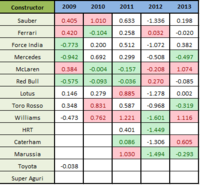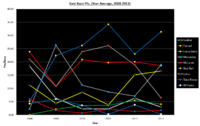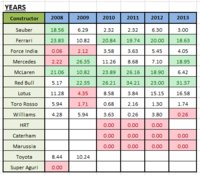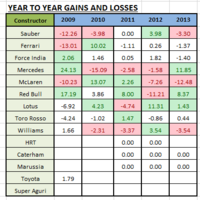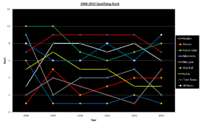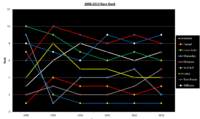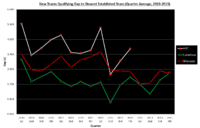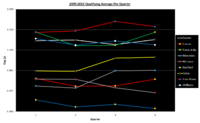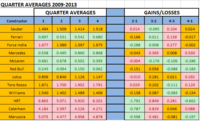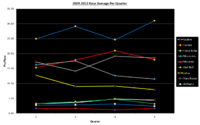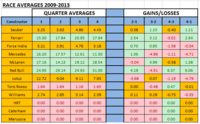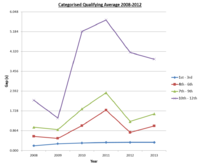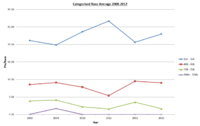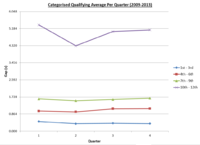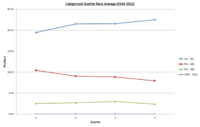This is a continuation of the “Development Race” article I made around this time last year looking at the performance of the teams both in the races and in qualifying from 2008 to 2012. I have now had a look at 2013 and updated the results and graphs etc. For those of you that haven’t seen (or forgotten about) the previous article I will write a summary of what this is all about and what I’ve done, but you’ll find more details if you look back at the original post (or just ask me here if you don’t understand something).
The basic idea is to look at how the competitiveness of the teams changes during the season and/or how it has changed from season to season. We probably all have a feeling for the ebbs and flows of a season but it is easy to miss something and it is interesting to put numbers on questions like “just how far back to McLaren drop in 2013?”.
To do this I look at both qualifying and the races in different ways, as follows:
Qualifying: The fastest time set by either of a team’s driver in a dry qualifying session, to give an indication of the ultimate raw pace of the car.
Race: The combined total points score for both drivers in a team in both wet and dry races, to look at the overall performance of the team taking in to account all factors (reliability, driver errors, strategy etc. etc.).
Finally, to make the trends clearer I will show the data as averages for each quarter of the season. For 2013 the races counting to each quarter of the season are as follows:

2013
SEASON MEMORY REFRESHER:
QUALIFYING RESULTS:
Established teams:
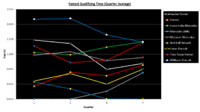
New teams:
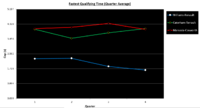
Table:

The qualifying results for me are the most interesting so I’ll start here again. First of all though I will add a little caveat about the accuracy of the stats. In 2013 there were quite a few wet qualifying sessions and this means that only two and a bit races count towards the 1st and 2nd quarter results. This means that in some cases the results are quite sensitive to an unusually poor qualifying for a team or strategic decisions to compromise Q3 for a better race strategy.
One example of this is Red Bull, who pop out as only the third fastest team in qualifying trim in the first quarter of the season using this approach. They didn’t have the fastest car in qualifying trim at the start of the season but they were probably faster than Ferrari and they are hurt by Webber’s refueling issue and Vettel’s decision not to set a time in Q3 in China. Nevertheless, the overall picture is the correct and familiar one – they improve in every quarter and by the end of the year they have a huge advantage – an average of eight tenths to their nearest rivals!
Another factor to possibly consider when looking at Red Bull’s rise to the top is the move back to the 2012 spec Pirelli tyres, which happened after the second quarter. It’s difficult to say how significant it was, but we can see that Williams (5 tenths) and Sauber (7 tenths) gained significantly around this time, whereas Force India fell back a couple of tenths. At the front there’s a half second swing between Red Bull and Mercedes. It does seem that the midfield teams that were strong in 2012 (Williams and Sauber) gained around the time of the tyre change but there’s a lot of other factors at play. There was a lot of speculation about how Red Bull could unlock extra potential
in their car with the 2012 tyres but just how large a role it played is very difficult to say.
I’ve mentioned them once or twice already but, building on a promising start to 2012 and with the added impetus of Hamilton’s arrival, Mercedes were the biggest gainers of 2013 and in fact for the first half of the season had the fastest car on Saturdays. They fall behind the relentless bull later but always maintain the edge on Ferrari and Lotus. Ferrari and Lotus themselves have a pretty close battle for 3rd, with Lotus having the edge after the start of the season.
In the midfield I have already mentioned the reversed fortunes of Sauber and Force India at the start/end of the season – Sauber propel themselves to within half a tenth of Ferrari whereas Force India slide all the way down to the back of the midfield after a promising start. Williams start way back, 8 tenths off the nearest midfield team, but do eventually claw themselves back in to contention with Force India and Toro Rosso (who were not worst of the established teams for a change) at least. That leaves one big name I haven’t mentioned yet – McLaren. They completely cocked up their new car, ended up in the midfield and stayed there, that’s all there really is to say.
Finally, a quick note about the bottom feeders. Marussia had probably their most competitive year so far and matched Caterham at the beginning and end of the season, which was enough for them to steal 10th in the constructors. Neither of them got close to challenging a “proper” team however, and if that doesn’t happen in 2014 you have to wonder whether it ever will.
RACE RESULTS AND COMPARISON WITH QUALIFYING:
Graph:

Table:

Race vs, Qualifying Rank:

I’ll keep this short as we’ve covered pretty much everything in the qualifying section. The race stats, and the graph in particular, do make Red Bull’s advantage as the best overall package (if not always the best qualifying package) across the whole season apparent. As well known, Mercedes were generally much less competitive in the races than qualifying and often fell behind Lotuses/Ferraris. Perhaps in contrast to general opinion, Ferrari appear to have had a better race car than Lotus as although Lotus had the edge in qualifying, Ferrari brought home more points (the Alonso factor maybe). In the midfield Toro Rosso tended to fall back in the races whereas Force India moved up the grid, probably thanks to some Red Bull seat winning performances from Ricciardo on Saturdays and on the other hand quite a few cock ups on Saturdays from Force India.
The basic idea is to look at how the competitiveness of the teams changes during the season and/or how it has changed from season to season. We probably all have a feeling for the ebbs and flows of a season but it is easy to miss something and it is interesting to put numbers on questions like “just how far back to McLaren drop in 2013?”.
To do this I look at both qualifying and the races in different ways, as follows:
Qualifying: The fastest time set by either of a team’s driver in a dry qualifying session, to give an indication of the ultimate raw pace of the car.
Race: The combined total points score for both drivers in a team in both wet and dry races, to look at the overall performance of the team taking in to account all factors (reliability, driver errors, strategy etc. etc.).
Finally, to make the trends clearer I will show the data as averages for each quarter of the season. For 2013 the races counting to each quarter of the season are as follows:
2013
SEASON MEMORY REFRESHER:
- Last year with the V8s but no really significant regulation changes.
- Vettel wins 9 races in a row to take another dominant WDC. Red Bull win the WCC again.
- Hamilton moves to a much improved Mercedes. Mercedes pick up 3 wins despite tyre wear issues.
- McLaren go for revolution instead of evolution with their new car… it backfires, ending up in the midfield and failing to pick up even a single podium.
- Mercedes have a sneaky private tyre test. The grey area they found was big enough to avoid serious punishment.
- Pirelli tyre farce. New tyre construction leads to multiple and random tyre failures in the first half of the season. They move back to 2012 spec tyres, probably contributing to a poor end to the year for the strong starting Force India and the dominant end to the year for Red Bull.
- Multi 21 Seb – Vettel ignores team orders and overtakes Webber at the Malaysian Grand Prix. Webber goes on to announce his retirement later in the season.
- Other things – Alonso gets 2nd in the WDC again, Grosjean cuts out the crashes, Williams fall way back again.
QUALIFYING RESULTS:
Established teams:

New teams:

Table:

The qualifying results for me are the most interesting so I’ll start here again. First of all though I will add a little caveat about the accuracy of the stats. In 2013 there were quite a few wet qualifying sessions and this means that only two and a bit races count towards the 1st and 2nd quarter results. This means that in some cases the results are quite sensitive to an unusually poor qualifying for a team or strategic decisions to compromise Q3 for a better race strategy.
One example of this is Red Bull, who pop out as only the third fastest team in qualifying trim in the first quarter of the season using this approach. They didn’t have the fastest car in qualifying trim at the start of the season but they were probably faster than Ferrari and they are hurt by Webber’s refueling issue and Vettel’s decision not to set a time in Q3 in China. Nevertheless, the overall picture is the correct and familiar one – they improve in every quarter and by the end of the year they have a huge advantage – an average of eight tenths to their nearest rivals!
Another factor to possibly consider when looking at Red Bull’s rise to the top is the move back to the 2012 spec Pirelli tyres, which happened after the second quarter. It’s difficult to say how significant it was, but we can see that Williams (5 tenths) and Sauber (7 tenths) gained significantly around this time, whereas Force India fell back a couple of tenths. At the front there’s a half second swing between Red Bull and Mercedes. It does seem that the midfield teams that were strong in 2012 (Williams and Sauber) gained around the time of the tyre change but there’s a lot of other factors at play. There was a lot of speculation about how Red Bull could unlock extra potential
in their car with the 2012 tyres but just how large a role it played is very difficult to say.
I’ve mentioned them once or twice already but, building on a promising start to 2012 and with the added impetus of Hamilton’s arrival, Mercedes were the biggest gainers of 2013 and in fact for the first half of the season had the fastest car on Saturdays. They fall behind the relentless bull later but always maintain the edge on Ferrari and Lotus. Ferrari and Lotus themselves have a pretty close battle for 3rd, with Lotus having the edge after the start of the season.
In the midfield I have already mentioned the reversed fortunes of Sauber and Force India at the start/end of the season – Sauber propel themselves to within half a tenth of Ferrari whereas Force India slide all the way down to the back of the midfield after a promising start. Williams start way back, 8 tenths off the nearest midfield team, but do eventually claw themselves back in to contention with Force India and Toro Rosso (who were not worst of the established teams for a change) at least. That leaves one big name I haven’t mentioned yet – McLaren. They completely cocked up their new car, ended up in the midfield and stayed there, that’s all there really is to say.
Finally, a quick note about the bottom feeders. Marussia had probably their most competitive year so far and matched Caterham at the beginning and end of the season, which was enough for them to steal 10th in the constructors. Neither of them got close to challenging a “proper” team however, and if that doesn’t happen in 2014 you have to wonder whether it ever will.
RACE RESULTS AND COMPARISON WITH QUALIFYING:
Graph:

Table:

Race vs, Qualifying Rank:

I’ll keep this short as we’ve covered pretty much everything in the qualifying section. The race stats, and the graph in particular, do make Red Bull’s advantage as the best overall package (if not always the best qualifying package) across the whole season apparent. As well known, Mercedes were generally much less competitive in the races than qualifying and often fell behind Lotuses/Ferraris. Perhaps in contrast to general opinion, Ferrari appear to have had a better race car than Lotus as although Lotus had the edge in qualifying, Ferrari brought home more points (the Alonso factor maybe). In the midfield Toro Rosso tended to fall back in the races whereas Force India moved up the grid, probably thanks to some Red Bull seat winning performances from Ricciardo on Saturdays and on the other hand quite a few cock ups on Saturdays from Force India.





